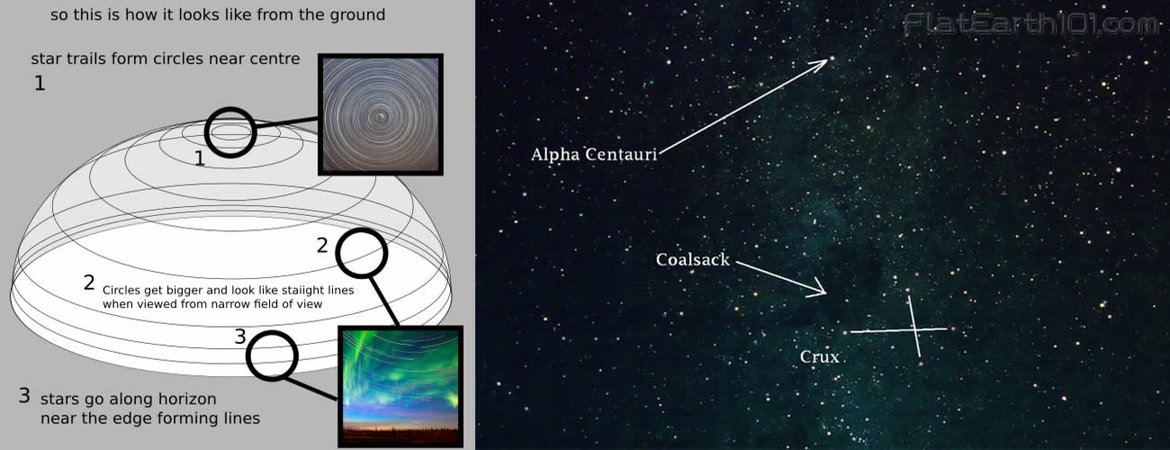51) Antarctica is by far the coldest place on Earth with an average annual temperature of approximately -57 degrees Fahrenheit, and a record low of -135.8! The average annual temperature at the North Pole, however, is a comparatively warm 4 degrees. Throughout the year, temperatures in the Antarctic vary less than half the amount at comparable Arctic latitudes. The Northern Arctic region enjoys moderately warm summers and manageable winters, whereas the Southern Antarctic region never even warms enough to melt the perpetual snow and ice. On a tilting, wobbling, ball-Earth spinning uniformly around the Sun, Arctic and Antarctic temperatures and seasons should not vary so greatly.
52) Iceland at 65 degrees North latitude is home to 870 species of native plants and abundant various animal life. Compare this with the Isle of Georgia at just 54 degrees South latitude where there are only 18 species of native plants and animal life is almost non-existent. The same latitude as Canada or England in the North where dense forests of various tall trees abound, the infamous Captain Cook wrote of Georgia that he was unable to find a single shrub large enough to make a toothpick! Cook wrote, “Not a tree was to be seen. The lands which lie to the south are doomed by nature to perpetual frigidness – never to feel the warmth of the sun’s rays; whose horrible and savage aspect I have not words to describe. Even marine life is sparse in certain tracts of vast extent, and the sea-bird is seldom observed flying over such lonely wastes. The contrasts between the limits of organic life in Arctic and Antarctic zones is very remarkable and significant.”

53) At places of comparable latitude North and South, the Sun behaves very differently than it would on a spinning ball Earth but precisely how it should on a flat Earth. For example, the longest summer days North of the equator are much longer than those South of the equator, and the shortest winter days North of the equator are much shorter than the shortest South of the equator. This is inexplicable on a uniformly spinning, wobbling ball Earth but fits exactly on the flat model with the Sun traveling circles over and around the Earth from Tropic to Tropic.
54) At places of comparable latitude North and South, dawn and dusk happen very differently than they would on a spinning ball, but precisely how they should on a flat Earth. In the North dawn and dusk come slowly and last far longer than in the South where they come and go very quickly. Certain places in the North twilight can last for over an hour while at comparable Southern latitudes within a few minutes the sunlight completely disappears. This is inexplicable on a uniformly spinning, wobbling ball Earth but is exactly what is expected on a flat Earth with the Sun traveling faster, wider circles over the South and slower, narrower circles over the North.
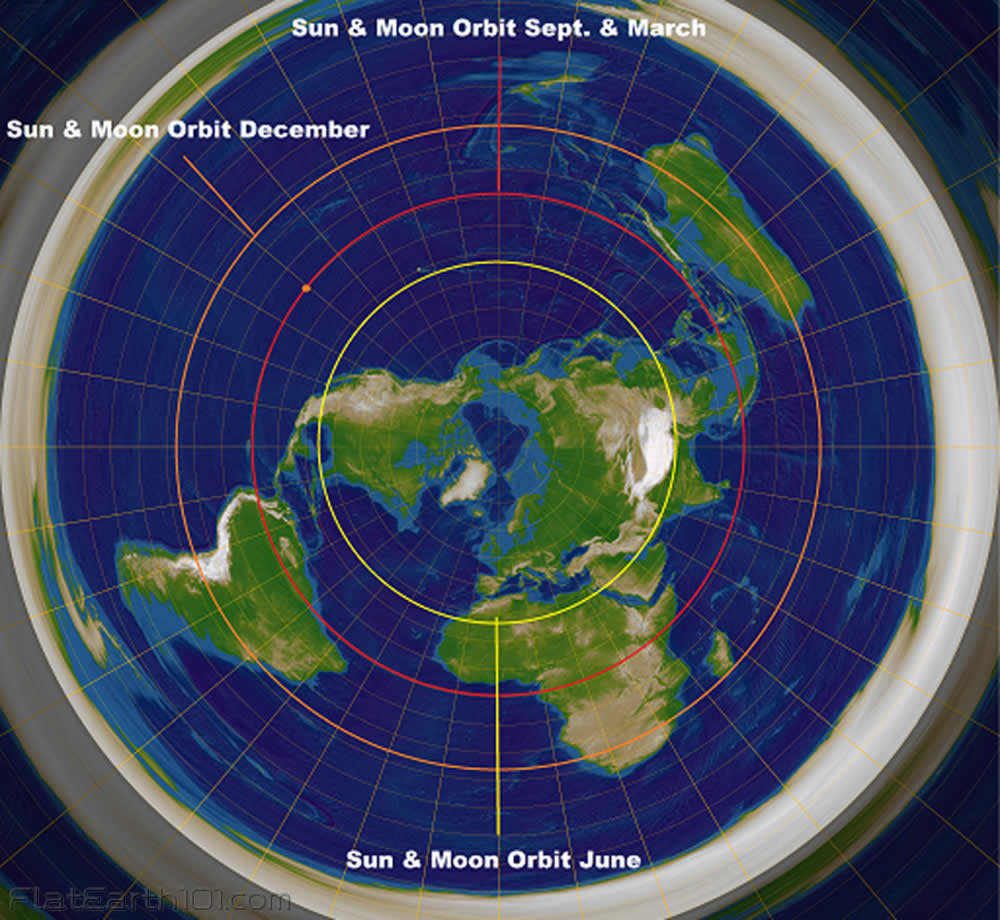
55) If the Sun circles over and around the Earth every 24 hours, steadily travelling from Tropic to Tropic every 6 months, it follows that the Northern, central region would annually receive far more heat and sunlight than the Southern circumferential region. Since the Sun must sweep over the larger Southern region in the same 24 hours it has to pass over the smaller Northern region, its passage must necessarily be proportionally faster as well. This perfectly explains the differences in Arctic/Antarctic temperatures, seasons, length of daylight, plant and animal life; this is why the Antarctic morning dawn and evening twilight are very abrupt compared with the North; and this explains why many midsummer Arctic nights the Sun does not set at all!
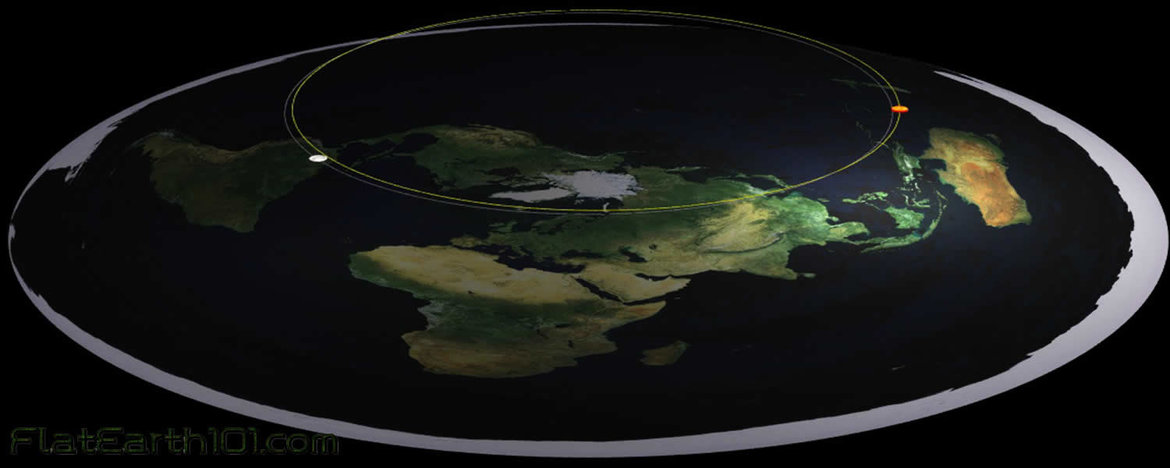
56) The “Midnight Sun” is an Arctic phenomenon occurring annually during the summer solstice where for several days straight an observer significantly far enough north can watch the Sun traveling circles over-head, rising and falling in the sky throughout the day, but never fully setting for upwards of 72+ hours! If the Earth were actually a spinning globe revolving around the Sun, the only place such a phenomenon as the Midnight Sun could be observed would be at the poles. Any other vantage point from 89 degrees latitude downwards could never, regardless of any tilt or inclination, see the Sun for 24 hours straight. To see the Sun for an entire revolution on a spinning globe at a point other than the poles, you would have to be looking through miles and miles of land and sea for part of the revolution!
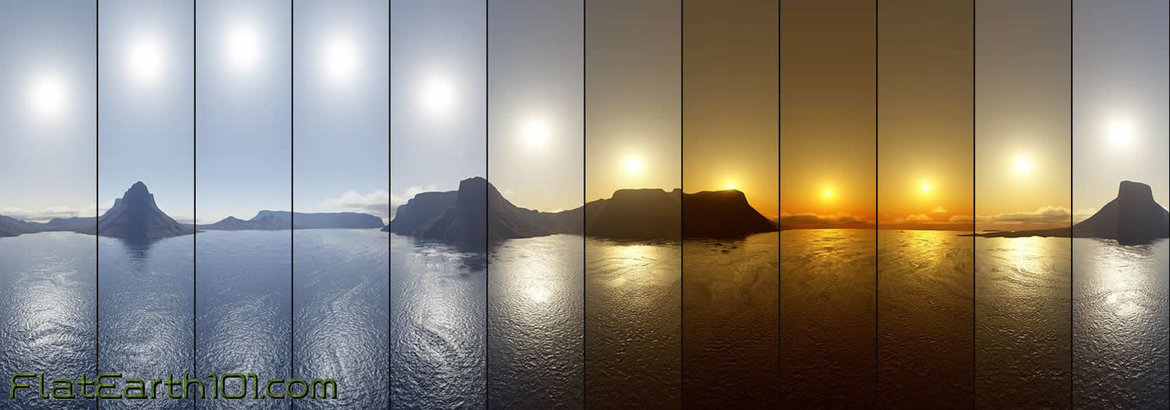
57) The establishment claims the Midnight Sun IS experienced in Antarctica but they conveniently do not have any uncut videos showing this, nor do they allow independent explorers to travel to Antarctica during the winter solstice to verify or refute these claims. Conversely, there are dozens of uncut videos publicly available showing the Arctic Midnight Sun and it has been verified beyond any shadow of a doubt.

58) The Royal Belgian Geographical Society in their “Expedition Antarctique Belge,” recorded that during the most severe part of the Antarctic winter, from 71 degrees South latitude onwards, the sun sets on May 17th and is not seen above the horizon again until July 21st! This is completely at odds with the ball-Earth theory, but easily explained by the flat-Earth model. The Midnight Sun is seen from high altitudes in extreme Northern latitudes during Arctic summer because the Sun, at its inner-most cycle, is circling tightly enough around the polar center that it remains visible above the horizon for someone at such a vantage point. Likewise, in extreme Southern latitudes during Arctic summer, the Sun completely disappears from view for over 2 months because there at the Northern Tropic, at the inner-most arc of its boomerang journey, the Sun is circling the Northern center too tightly to be seen from the Southern circumference.
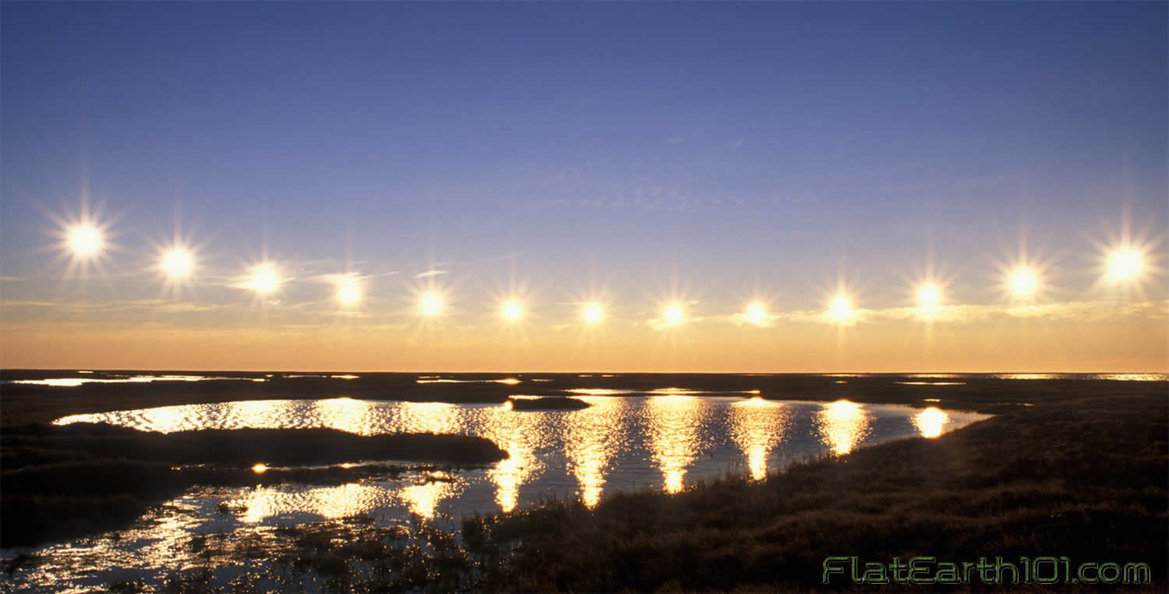
59) Quoting Gabrielle Henriet, “The theory of the rotation of the earth may once and for all be definitely disposed of as impracticable by pointing out the following inadvertence. It is said that the rotation takes twenty-four hours and that its speed is uniform, in which case, necessarily, days and nights should have an identical duration of twelve hours each all the year round. The sun should invariably rise in the morning and set in the evening at the same hours, with the result that it would be the equinox every day from the 1st of January to the 31st of December. One should stop and reflect on this before saying that the earth has a movement of rotation. How does the system of gravitation account for the seasonal variations in the lengths of days and nights if the earth rotates at a uniform speed in twenty-four hours!?”

60) Anyone can prove the sea-horizon perfectly straight and the entire Earth perfectly flat using nothing more than a level, tripods and a wooden plank. At any altitude above sea-level, simply fix a 6-12 foot long, smooth, leveled board edgewise upon tripods and observe the skyline from eye-level behind it. The distant horizon will always align perfectly parallel with the upper edge of the board. Furthermore, if you move in a half-circle from one end of the board to the other whilst observing the skyline over the upper edge, you will be able to trace a clear, flat 10-20 miles depending on your altitude. This would be impossible if the Earth were a globe 25,000 miles in circumference; the horizon would align over the center of the board but then gradually, noticeably decline towards the extremities. Just ten miles on each side would necessitate an easily visible curvature of 66.6 feet from each end to the center.

61) If the Earth were actually a big ball 25,000 miles in circumference, the horizon would be noticeably curved even at sea-level, and everything on or approaching the horizon would appear to tilt backwards slightly from your perspective. Distant buildings along the horizon would all look like leaning towers of Piza falling away from the observer. A hot-air balloon taking off then drifting steadily away from you, on a ball-Earth would slowly and constantly appear to lean back more and more the farther away it flew, the bottom of the basket coming gradually into view as the top of the balloon disappears from sight. In reality, however, buildings, balloons, trees, people, anything and everything at right angles to the ground/horizon remains so regardless the distance or height of the observer.
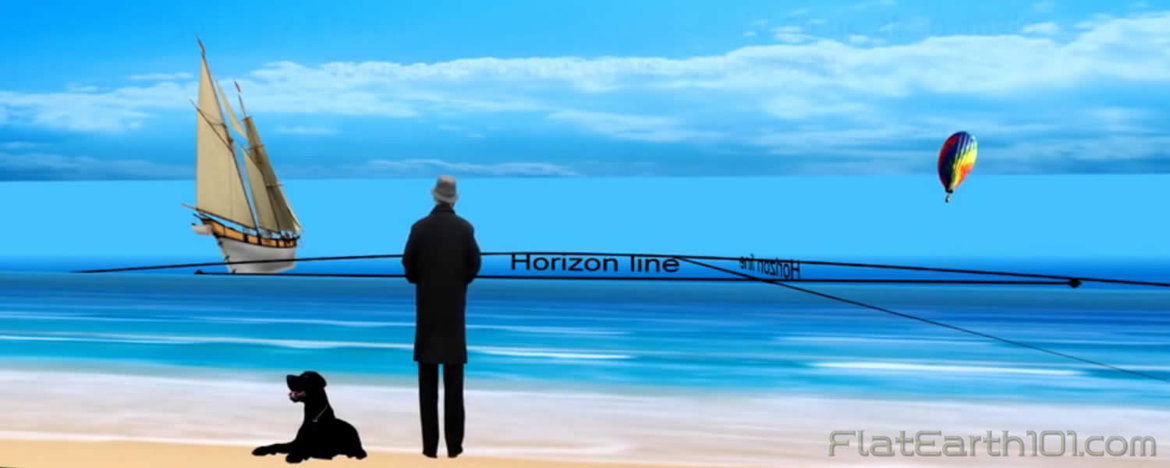
62) Samuel Rowbotham’s experiments at the Old Bedford Level proved conclusively the canal’s water to be completely flat over a 6 mile stretch. First he stood in the canal with his telescope held 8 inches above the surface of the water, then his friend in a boat with a 5 foot tall flag sailed the 6 miles away. If Earth were a ball 25,000 miles in circumference the 6 mile stretch of water should have comprised an arc exactly 6 feet high in the middle, so the entire boat and flag should have ultimately disappeared, when in fact the entire boat and flag remained visible at the same height for the entire journey.
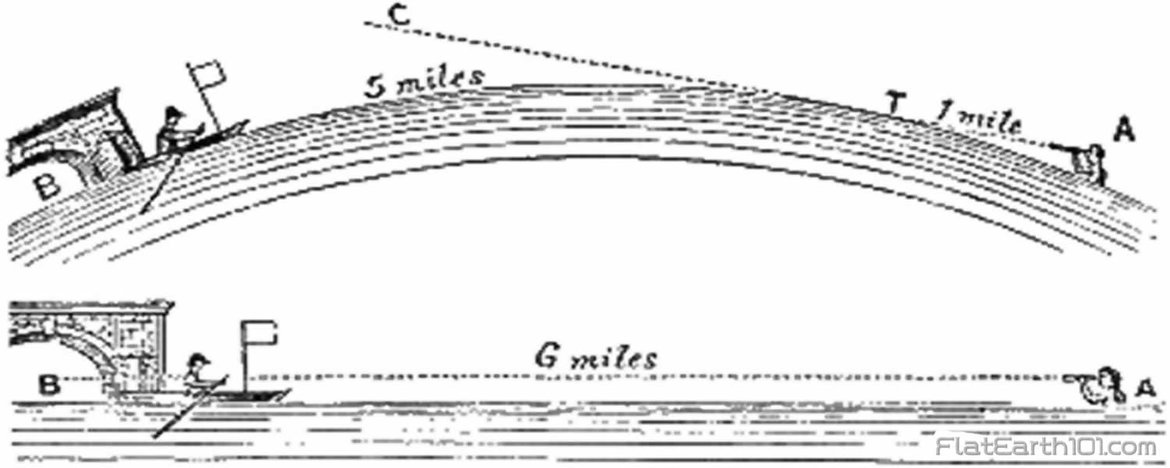
63) In a second experiment Dr. Rowbotham affixed flags 5 feet high along the shoreline, one at every mile marker. Then using his telescope mounted at 5 feet just behind the first flag looked over the tops of all 6 flags which lined up in a perfectly straight line. If the Earth were a ball 25,000 miles in circumference the flags should have progressively dipped down after the first establishing line of sight, the second would have descended 8 inches, 32 inches for the third, 6 feet for the fourth, 10 feet 8 inches for the fifth, and 16 feet 8 inches for the sixth.
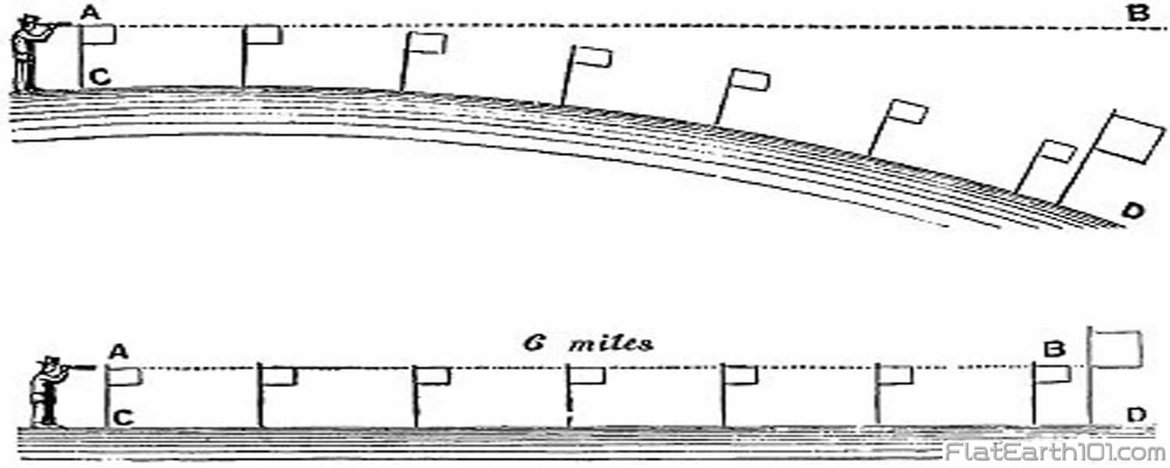
64) Quoting “Earth Not a Globe!” by Samuel Rowbotham, “It is known that the horizon at sea, whatever distance it may extend to the right and left of the observer on land, always appears as a straight line. The following experiment has been tried in various parts of the country. At Brighton, on a rising ground near the race course, two poles were fixed in the earth six yards apart, and directly opposite the sea. Between these poles a line was tightly stretched parallel to the horizon. From the center of the line the view embraced not less than 20 miles on each side making a distance of 40 miles. A vessel was observed sailing directly westwards; the line cut the rigging a little above the bulwarks, which it did for several hours or until the vessel had sailed the whole distance of 40 miles. The ship coming into view from the east would have to ascend an inclined plane for 20 miles until it arrived at the center of the arc, whence it would have to descend for the same distance. The square of 20 miles multiplied by 8 inches gives 266 feet as the amount the vessel would be below the line at the beginning and at the end of the 40 miles.”
65) Also Quoting Dr. Rowbotham, “On the shore near Waterloo, a few miles to the north of Liverpool, a good telescope was fixed, at an elevation of 6 feet above the water. It was directed to a large steamer, just leaving the River Mersey, and sailing out to Dublin. Gradually the mast-head of the receding vessel came nearer to the horizon, until, at length, after more than four hours had elapsed, it disappeared. The ordinary rate of sailing of the Dublin steamers was fully eight miles an hour; so that the vessel would be, at least, thirty-two miles distant when the mast-head came to the horizon. The 6 feet of elevation of the telescope would require three miles to be deducted for convexity, which would leave twenty-nine miles, the square of which, multiplied by 8 inches, gives 560 feet; deducting 80 feet for the height of the main-mast, and we find that, according to the doctrine of rotundity, the mast-head of the outward bound steamer should have been 480 feet below the horizon. Many other experiments of this kind have been made upon sea-going steamers, and always with results entirely incompatible with the theory that the earth is a globe.”
66) Dr. Rowbotham conducted several other experiments using telescopes, spirit levels, sextants and “theodolites,” special precision instruments used for measuring angles in horizontal or vertical planes. By positioning them at equal heights aimed at each other successively he proved over and over the Earth to be perfectly flat for miles without a single inch of curvature. His findings caused quite a stir in the scientific community and thanks to 30 years of his efforts, the shape of the Earth became a hot topic of debate around the turn of the nineteenth century.
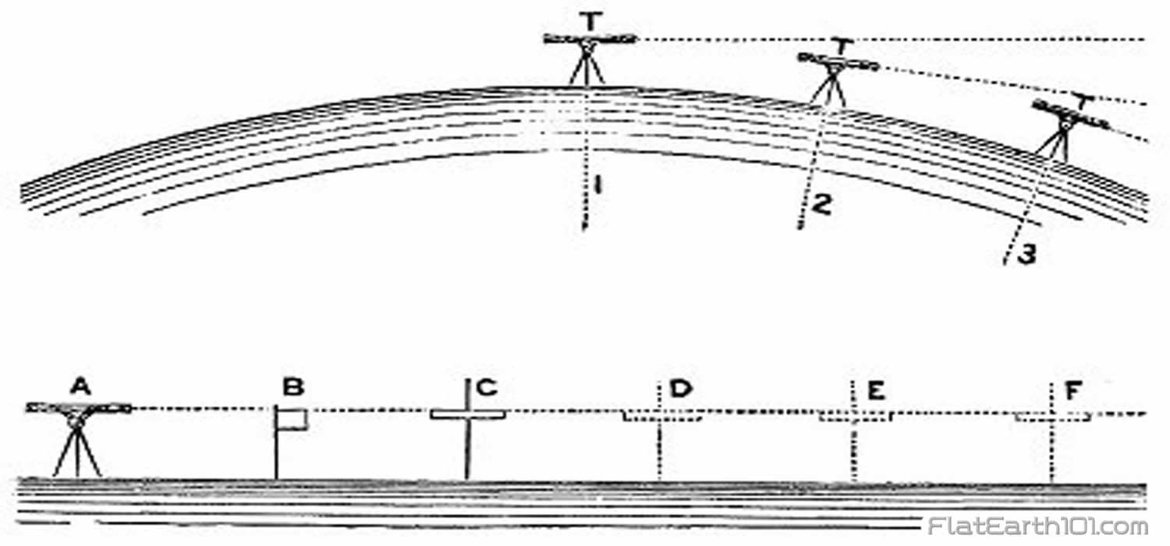
67) The distance across the Irish Sea from the Isle of Man’s Douglas Harbor to Great Orm’s Head in North Wales is 60 miles. If the Earth was a globe then the surface of the water between them would form a 60 mile arc, the center towering 1944 feet higher than the coastlines at either end. It is well-known and easily verifiable, however, that on a clear day, from a modest altitude of 100 feet, the Great Orm’s Head is visible from Douglas Harbor. This would be completely impossible on a globe of 25,000 miles. Assuming the 100 foot altitude causes the horizon to appear approximately 13 miles off, the 47 miles remaining means the Welsh coastline should still fall an impossible 1472 feet below the line of sight!

68) The Philadelphia skyline is clearly visible from Apple Pie Hill in the New Jersey Pine Barrens 40 miles away. If Earth were a ball 25,000 miles in circumference, factoring in the 205 foot elevation of Apple Pie Hill, the Philly skyline should remain well-hidden beyond 335 feet of curvature.
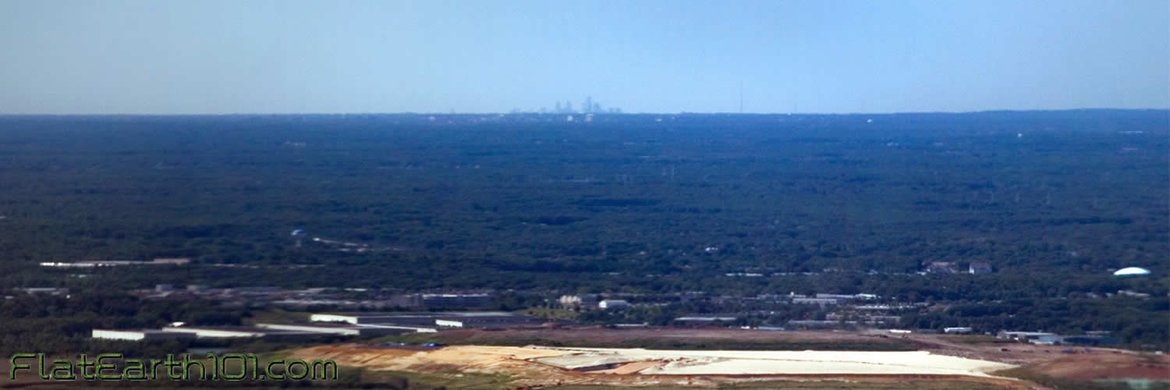
69) The New York City skyline is clearly visible from Harriman State Park’s Bear Mountain 60 miles away. If Earth were a ball 25,000 miles in circumference, viewing from Bear Mountain’s 1,283 foot summit, the Pythagorean Theorem determining distance to the horizon being 1.23 times the square root of the height in feet, the NYC skyline should be invisible behind 170 feet of curved Earth.

70) From Washington’s Rock in New Jersey, at just a 400 foot elevation, it is possible on a clear day to see the skylines of both New York and Philadelphia in opposite directions at the same time covering a total distance of 120 miles! If Earth were a ball 25,000 miles in circumference, both of these skylines should be hidden behind over 800 feet of Earth’s curvature.

71) It is often possible to see the Chicago skyline from sea-level 60 miles away across Lake Michigan. In 2015 after photographer Joshua Nowicki photographed this phenomenon several news channels quickly claimed his picture to be a “superior mirage,” an atmospheric anomaly caused by temperature inversion. While these certainly do occur, the skyline in question was facing right-side up and clearly seen unlike a hazy illusory mirage, and on a ball-Earth 25,000 miles in circumference should be 2,400 feet below the horizon.
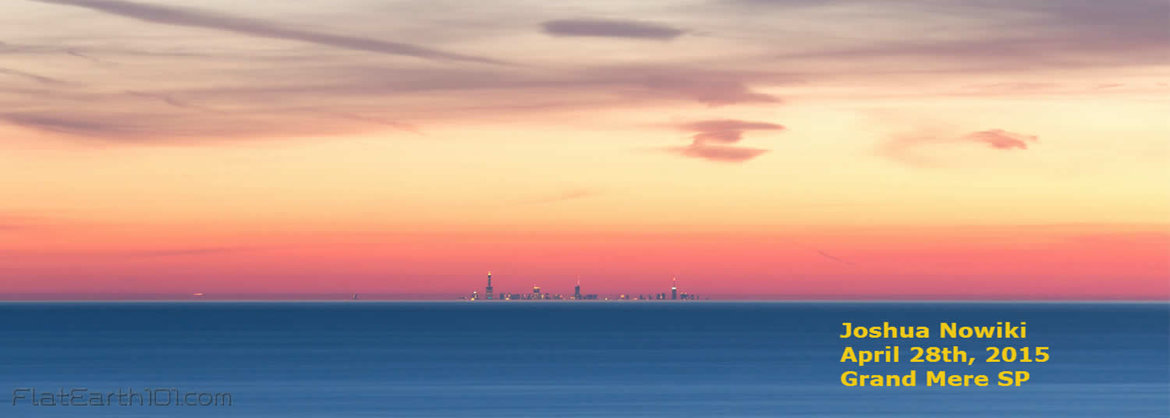
72) October 16, 1854 the Times newspaper reported the Queen’s visit to Great Grimsby from Hull recording they were able to see the 300 foot tall dock tower from 70 miles away. On a ball-Earth 25,000 miles in circumference, factoring their 10 foot elevation above the water and the tower’s 300 foot height, at 70 miles away the dock tower should have remained an entire 2,600 feet below the horizon.
73) In 1872 Capt. Gibson and crewmates, sailing the ship “Thomas Wood” from China to London, reported seeing the entirety of St. Helena Island on a clear day from 75 miles away. Factoring in their height during measurement on a ball-Earth 25,000 miles in circumference, it was found the island should have been 3,650 feet below their line of sight.
74) From Genoa, Italy at a height of just 70 feet above sea-level, the island of Gorgona can often be seen 81 miles away. If Earth were a ball 25,000 miles in circumference, Gorgona should be hidden beyond 3,332 feet of curvature.

75) From Genoa, Italy at a height of just 70 feet above sea-level, the island of Corsica can often be seen 99 miles away. If Earth were a ball 25,000 miles in circumference, Corsica should fall 5,245 feet, almost an entire mile below the horizon.

76) From Genoa, Italy 70 feet above sea-level, the island of Capraia 102 miles away can often be seen as well. If Earth were a ball 25,000 miles in circumference, Capraia should always remain hidden behind 5,605 feet, over a mile of supposed curvature.
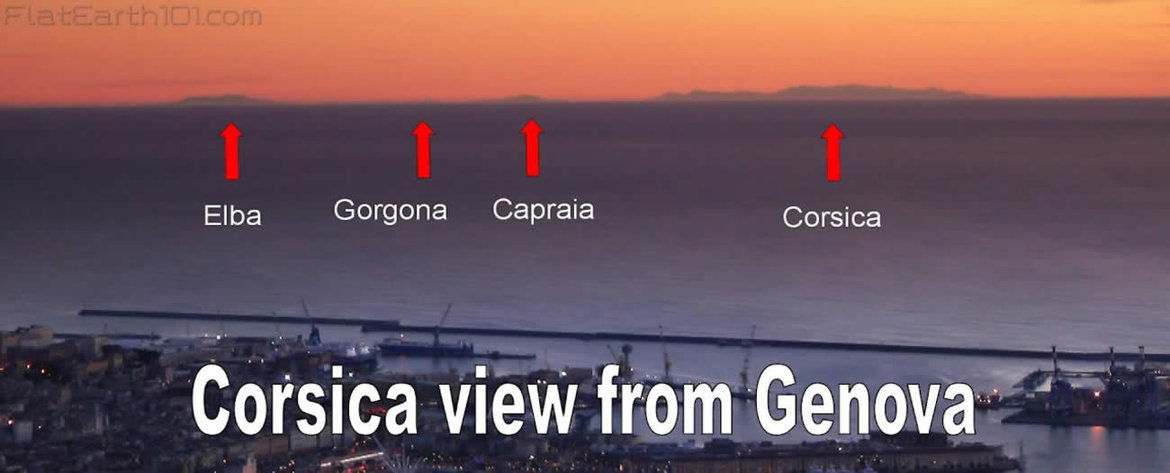
77) Also from Genoa, on bright clear days, the island of Elba can be seen an incredible 125 miles away! If Earth were a ball 25,000 miles in circumference, Elba should be forever invisible behind 8770 feet of curvature.
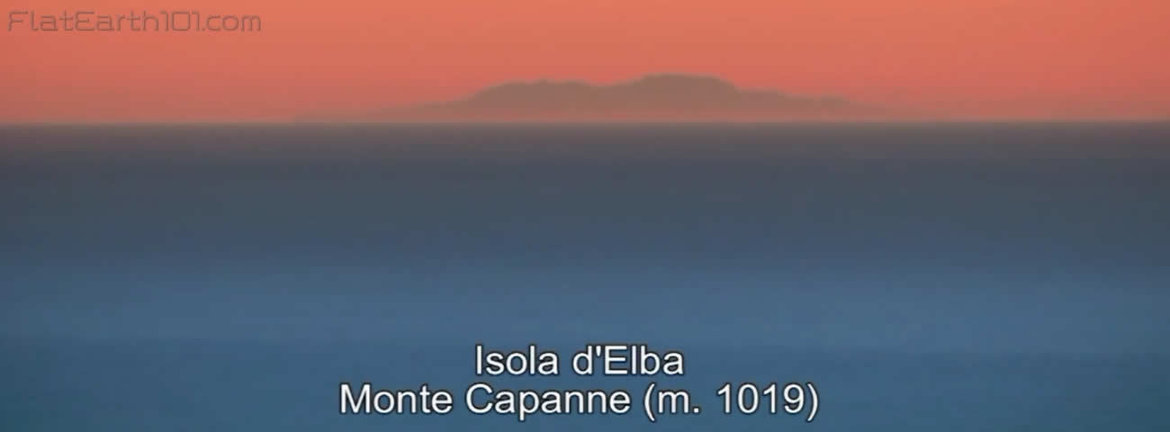
78) From Anchorage, Alaska at an elevation of 102 feet, on clear days Mount Foraker can be seen with the naked eye 120 miles away. If Earth were a ball 25,000 miles in circumference, Mount Foraker’s 17,400 summit should be leaning back away from the observer covered by 7,719 feet of curved Earth. In reality, however, the entire mountain can be quite easily seen standing straight from base to summit.

79) From Anchorage, Alaska at an elevation of 102 feet, on clear days Mount McKinley can be seen with the naked eye from 130 miles away. If Earth were a ball 25,000 miles in circumference, Mount McKinley’s 20,320 foot summit should be leaning back away from the observer and almost half covered by 9,220 feet of curved Earth. In reality, however, the entire mountain can be quite easily seen standing straight from base to summit.


80) In Chambers’ Journal, February 1895, a sailor near Mauritius in the Indian Ocean reported having seen a vessel which turned out to be an incredible 200 miles away! The incident caused much heated debate in nautical circles at the time, gaining further confirmation in Aden, Yemen where another witness reported seeing a missing Bombay steamer from 200 miles away. He correctly stated the precise appearance, location and direction of the steamer all later corroborated and confirmed correct by those onboard. Such sightings are absolutely inexplicable if the Earth were actually a ball 25,000 miles around, as ships 200 miles distant would have to fall approximately 5 miles below line of sight!
81) The distance from which various lighthouse lights around the world are visible at sea far exceeds what could be found on a ball-Earth 25,000 miles in circumference. For example, the Dunkerque Light in southern France at an altitude of 194 feet is visible from a boat (10 feet above sea-level) 28 miles away. Spherical trigonometry dictates that if the Earth was a globe with the given curvature of 8 inches per mile squared, this light should be hidden 190 feet below the horizon.
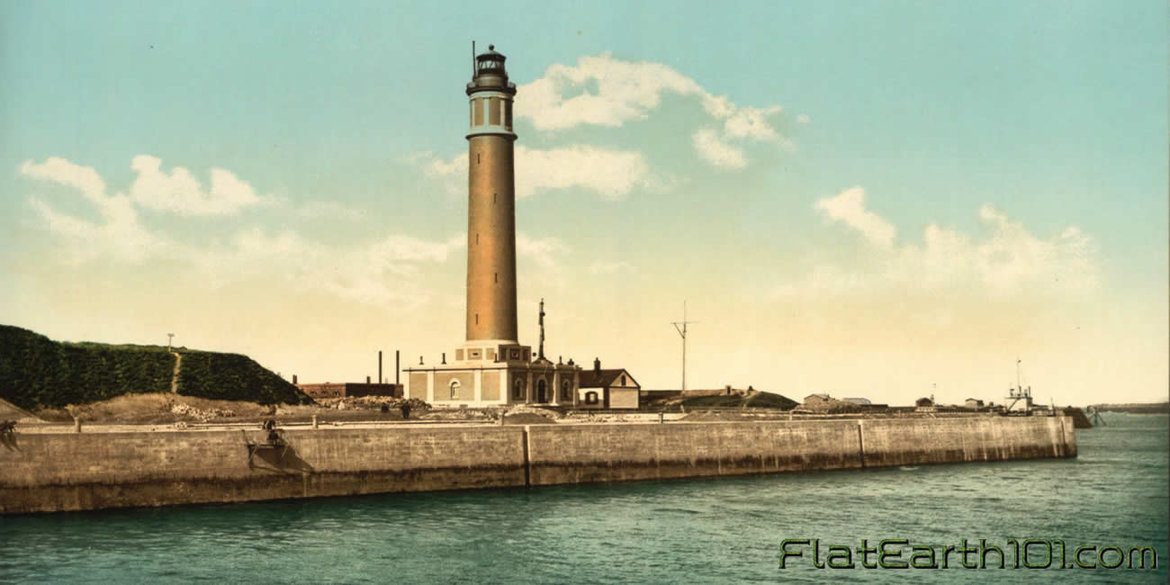
82) The Port Nicholson Light in New Zealand is 420 feet above sea-level and visible from 35 miles away where it should be 220 feet below the horizon.
83) The Egerö Light in Norway is 154 feet above high-water and visible from 28 statute miles where it should be 230 feet below the horizon.
84) The Light at Madras, on the Esplanade, is 132 feet high and visible from 28 miles away, where it should be 250 feet below the line of sight.
85) The Cordonan Light on the west coast of France is 207 feet high and visible from 31 miles away, where it should be 280 feet below the line of sight.
86) The light at Cape Bonavista, Newfoundland is 150 feet above sea-level and visible at 35 miles, where it should be 491 feet below the horizon.
87) The lighthouse steeple of St. Botolph’s Parish Church in Boston is 290 feet tall and visible from over 40 miles away, where it should be hidden a full 800 feet below the horizon!
88) The Isle of Wight lighthouse in England is 180 feet high and can be seen up to 42 miles away, a distance at which modern astronomers say the light should fall 996 feet below line of sight.
89) The Cape L’Agulhas lighthouse in South Africa is 33 feet high, 238 feet above sea level, and can be seen for over 50 miles. If the world were a globe, this light would fall 1,400 feet below an observer’s line of sight.
90) The Statue of Liberty in New York stands 326 feet above sea level and on a clear day can be seen as far as 60 miles away. If the Earth were a globe, that would put Lady Liberty at an impossible 2,074 feet below the horizon.

91) The lighthouse at Port Said, Egypt, at an elevation of only 60 feet has been seen an astonishing 58 miles away, where, according to modern astronomy it should be 2,182 feet below the line of sight!
92) The Notre Dame Antwerp spire stands 403 feet high from the foot of the tower with Strasburg measuring 468 feet above sea level. With the aid of a telescope, ships can be distinguished on the horizon and captains declare they can see the cathedral spire from an amazing 150 miles away. If the Earth were a globe, however, at that distance the spire should be an entire mile, 5,280 feet below the horizon!

93) The St. George’s Channel between Holyhead and Kingstown Harbor near Dublin is 60 miles across. When half-way across a ferry passenger will notice behind them the light on Holyhead pier as well as in front of them the Poolbeg light in Dublin Bay. The Holyhead Pier light is 44 feet high, while the Poolbeg lighthouse 68 feet, therefore a vessel in the middle of the channel, 30 miles from either side standing on a deck 24 feet above the water, can clearly see both lights. On a ball Earth 25,000 miles in circumference, however, both lights should be hidden well below both horizons by over 300 feet!
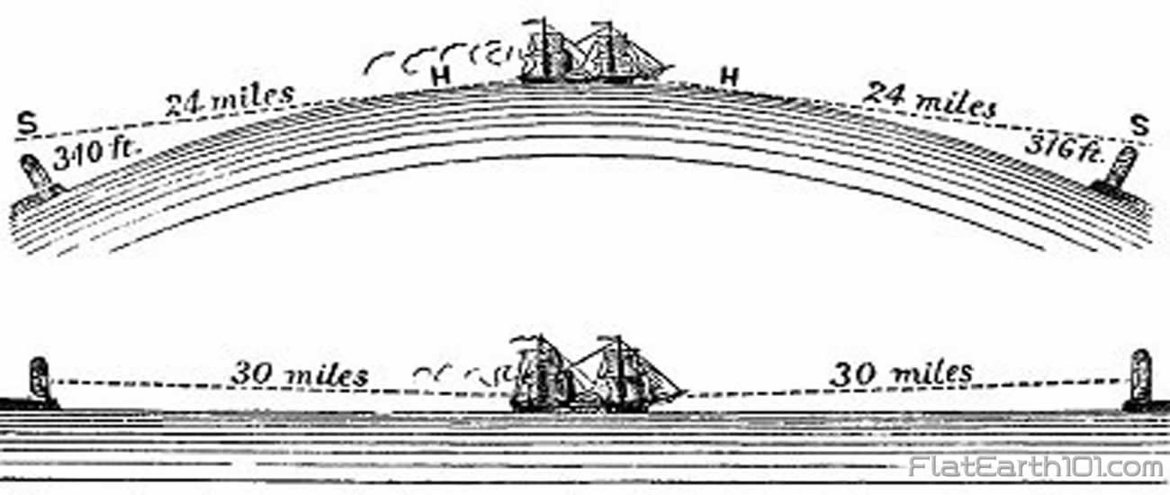
94) From the highland near Portsmouth Harbor in Hampshire, England looking across Spithead to the Isle of Wight, the entire base of the island, where water and land come together composes a perfectly straight line 22 statute miles long. According to the ball-Earth theory, the Isle of Wight should decline 80 feet from the center on each side to account for the necessary curvature. The cross-hairs of a good theodolite directed there, however, have repeatedly shown the land and water line to be perfectly level.
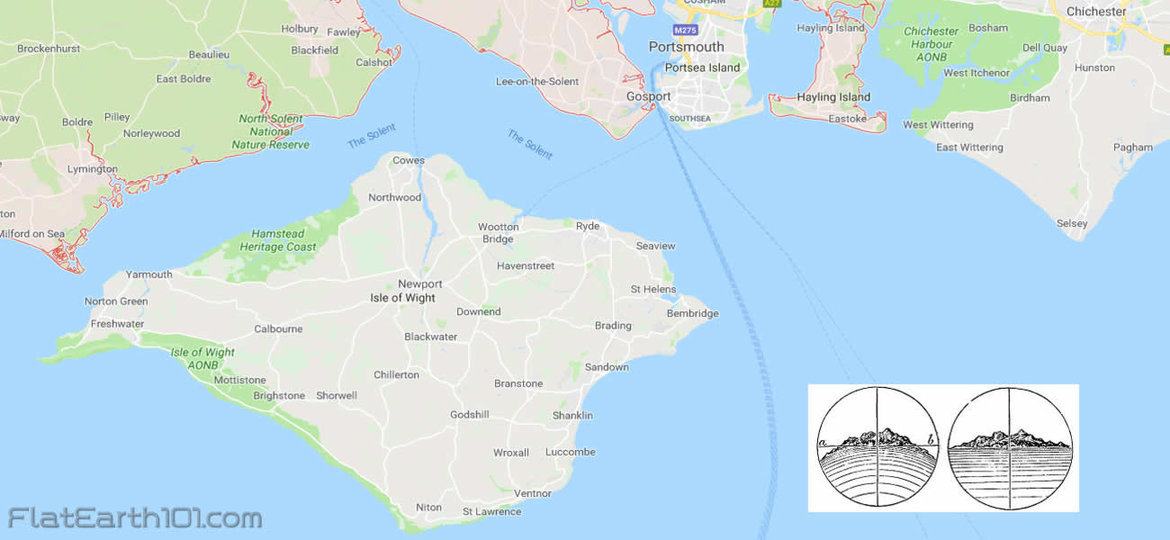
95) On a clear day from the highland near Douglas Harbor on the Isle of Man, the whole length of the coast of North Wales is often plainly visible to the naked eye. From the Point of Ayr at the mouth of the River Dee to Holyhead comprises a 50 mile stretch which has also been repeatedly found to be perfectly horizontal. If the Earth actually had curvature of 8 inches per mile squared, as NASA and modern astronomy claim, the 50 mile length of Welsh coast seen along the horizon in Liverpool Bay would have to decline from the center-point an easily detectable 416 feet on each side!
96) From “100 Proofs the Earth is Not a Globe” by William Carpenter, “If we take a journey down the Chesapeake Bay, by night, we shall see the ‘light’ exhibited at Sharpe’s Island for an hour before the steamer gets to it. We may take up a position on the deck so that the rail of the vessel’s side will be in a line with the ‘light’ and in the line of sight; and we shall find that in the whole journey the light won’t vary in the slightest degree in its apparent elevation. But, say that a distance of thirteen miles has been traversed, the astronomers’ theory of ‘curvature’ demands a difference (one way or the other!) in the apparent elevation of the light, of 112 feet 8 inches! Since, however, there is not a difference of 100 hair’s breadths, we have a plain proof that the water of the Chesapeake Bay is not curved, which is a proof that the Earth is not a globe.”
97) NASA and modern astronomy say the Earth is a giant ball tilted back, wobbling and spinning 1,000 mph around its central axis, traveling 67,000 mph circles around the Sun, spiraling 500,000 mph around the Milky Way, while the entire galaxy rockets a ridiculous 670,000,000 mph through the Universe, with all of these motions originating from an alleged “Big Bang” cosmogenic explosion 14 billion years ago. That’s a grand total of 670,568,000 mph in several different directions we’re all supposedly speeding along at simultaneously, yet no one has ever seen, felt, heard, measured or proven a single one of these motions to exist whatsoever.
98) NASA and modern astronomy say Polaris, the North Pole star, is somewhere between 323-434 light years, or about 2 quadrillion miles, away from us! Firstly, note that is between 1,938,000,000,000,000 – 2,604,000,000,000,000 miles making a difference of 666,000,000,000,000 (over six hundred trillion) miles! If modern astronomy cannot even agree on the distance to stars within hundreds of trillions of miles, perhaps their “science” is flawed and their theory needs re-examining. However, even granting them their obscurely distant stars, it is impossible for heliocentrists to explain how Polaris manages to always remain perfectly aligned straight above the North Pole throughout Earth’s various alleged tilting, wobbling, rotating and revolving motions.

99) Viewed from a ball-Earth, Polaris, situated directly over the North Pole, should not be visible anywhere in the Southern hemisphere. For Polaris to be seen from the Southern hemisphere of a globular Earth, the observer would have to be somehow looking “through the globe,” and miles of land and sea would have to be transparent. Polaris can be seen, however, up to over 20 degrees South latitude.
100) If Earth were a ball, the Southern Cross and other Southern constellations would all be visible at the same time from every longitude on the same latitude as is the case in the North with Polaris and its surrounding constellations. Ursa Major/Minor and many others can be seen from every Northern meridian simultaneously whereas in the South, constellations like the Southern Cross cannot. This proves the Southern hemisphere is not “turned under” as in the ball-Earth model, but simply stretching further outwards away from the Northern center-point as in the flat Earth model.
